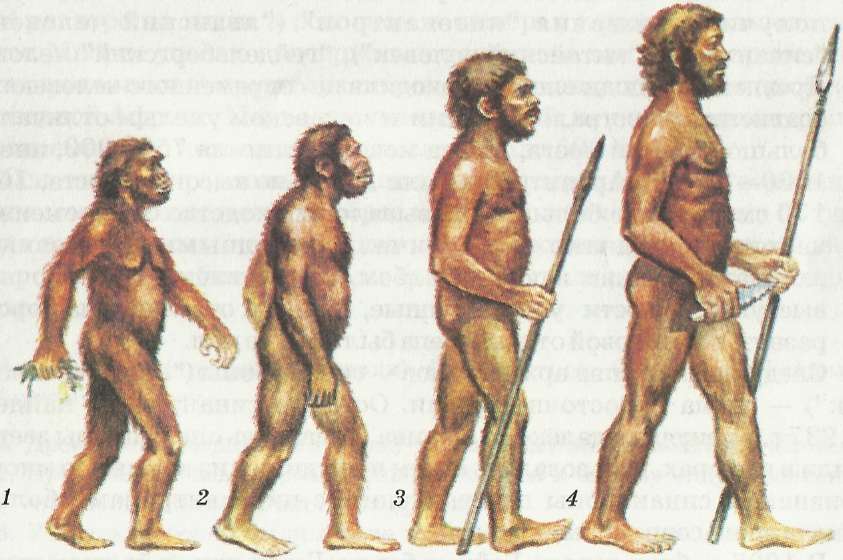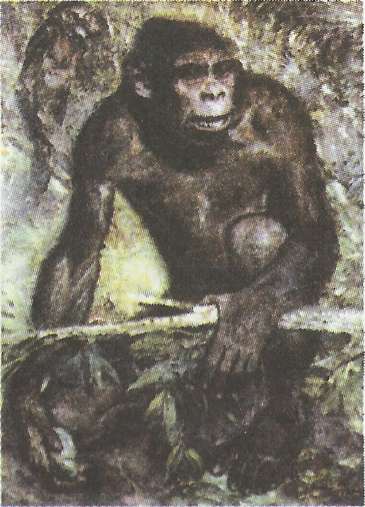The main stages of human evolution
The main feature separating great apes from humans is the mass of the brain. The mass of the brain of great apes does not exceed 450 g. With a brain mass of 750 g, the child masters speech. Excess brain mass is directly related to an increase in the volume of the cranium (Fig. 53).
Rice. 53. Changes in the volume of the cerebral part of the human skull in the process of historical development: 1 - giant Australopithecus; 2 - African Australopithecus; 3 - the most ancient person; 4 - ancient man (Neanderthal)
In the process of human development, three main stages are distinguished: 1) the most ancient people (archanthropes), 2) ancient people (paleoanthropes) and 3) modern people (neoanthropes) (Fig. 54).

Rice. 54. Ancestors of modern man: 1 - Australopithecus; 2 - Homo erectus (the oldest man); 3 - Neanderthal (ancient man); 4 - Cro-Magnon - the direct ancestor of modern man

Dutch anthropologist. The main scientific works are devoted to human evolution. Irrefutably proved the correctness of Charles Darwin's theory of the origin of man from closely related higher apes.
Ancient people (archanthropes). All groups of ancient people belong to a single species of upright people ( Homo erectns). In 1891, the Dutch scientist E. Dubois (1858-1940) found the fossil remains of the most ancient man on the island of Java. The age of this find is 1.9 million-600 thousand years. E. Dubois called him Pithecanthropus (Greek pithekos - "monkey" and anthropos - "man", that is, ape-man). The forehead of Pithecanthropus is strongly sloping, a solid bone ridge above the eyes protrudes forward, the occipital bone is advanced backward.
These were signs characteristic only of great apes. The mass of their brain reached 900 g, i.e., it was much larger than that of the great apes. Attention is drawn to the similarity in the structure of the femur of Pithecanthropus and humans, walking on two legs. According to some signs, they looked like monkeys, and according to others - like a person, therefore they received the name "monkey-man" (pithecanthropus). Later, their remains were found in China, Germany, Hungary, North and South Africa. When the fossil remains of Pithecanthropus were found, nothing was known about Australopithecus and Homo sapiens, so Pithecanthropes have long been considered a link between apes and humans (Fig. 55).

Rice. 55. Pithecanthropus
Now pithecanthropes are classified as archanthropes (the oldest people), or upright people ( Homo erectns). Despite significant external differences, all ancient people belong to the same species. Archanthropes lived on Earth from about 1 million to 500 thousand years ago. According to the location of the fossil remains, they received the names "Pithecanthropus" ("Javanese man"), "Sinanthropus" ("Chinese man"), "Heidelberg" man. The most ancient people outwardly resembled a modern person, compared with Australopithecus and a skilled man, they were distinguished by a large mass of the brain. The mass of the brain reached 750-900, sometimes 1000-1100 g. The archanthropes were quite tall, 165-170 cm, which further proved their resemblance to modern man. However, they were distinguished by powerful brow ridges, a low and sloping forehead, and the absence of a chin protrusion. Their jaws are large, the facial region of the skull is well developed, but the brain region of the skull was still small. The next group of archanthropes - Sinanthropes ("Chinese people") - lived in East Asia. The remains of synanthropes were found in 1937 in a cave near Beijing. They dressed in animal skins, lived in caves, used fire and stone tools. In many ways, Sinanthropes compared with Pithecanthropes were more like modern people.
In 1907, the remains of an ancient man were found near the city of Heidelberg in Germany. Scientists called him "Heidelberg Man" and attributed him to the archanthropes. Significant changes took place in the way of life of the archanthropes. They mainly hunted large animals together, knew how to use fire. Improved tools made of stone. They knew how to make cutting, chopping, sharp tools from stone. One of the main features in the history of the development of archanthropes is the appearance of speech. The word became the most important means of communication between them, since the frontal and temporal lobes of the brain associated with speech were quite well developed.
Fossil remains of archanthropes have been found in large numbers in Central and North Africa, Southern Europe, and Western Asia. There is an opinion that archanthropes gradually spread from these places to other parts of Europe and Asia.
On the territory of Kazakhstan, many remains of the dwellings of ancient people, stone tools used by them, and the remains of wild animals that they hunted were found. However, the remains of the most ancient people were not found. This is proved by archaeological research conducted recently in Kazakhstan. Stone Age tools were first found in 1928 in Kazakhstan near the Altyn Kolat pasture. Later, similar stone tools were found on the territory of the village of Kyzyltu in the Zhambyl region.
As a result of research, scientists have specified several areas of distribution of the most ancient people on the territory of Kazakhstan. Such areas include Mangistau, Ustyurt, Karatau in South Kazakhstan, the small hills of Kokshetau in the north and the regions of Naryn-Bukhtarma, Irtysh. Based on these data, Kazakh scientists Zh. Taymagambetov and others came to the conclusion that 1 million years ago, the most ancient people lived on the territory of Kazakhstan.
Archanthropes lived mainly in caves and could use fire. Many scholars support the view that modern humans descended from groups of archanthropes who lived in Central and North Africa. The period of the appearance of people, from archanthropes to modern man, covers about 500 thousand years.
The main directions in the evolution of archanthropes are an increase in the mass of the brain, a social way of life, the improvement of tools and the use of fire. However, biological factors played a major role in the evolution of archanthropes, among them natural selection.
Archanthropes (earliest people). Pithecanthropus. Sinanthropus. Heidelberg man.
1. What stages of human evolution do you know?
2. Give a description of synanthropes.
3. What groups of archanthropes existed?
1. Name the main directions of evolution of archanthropes.
2. Describe the main features of the body structure of archanthropes.
3. What signs of Pithecanthropus were similar to those of a monkey, and which were similar to those of a person?
1. Give a description of how, with an increase in the brain volume of individual groups, a change in the lifestyle of individual groups of archanthropes occurs.
2. Where were the sites and tools of archanthropes found in Kazakhstan?
3.Where in the world were the remains of individual groups of archanthropes found?
Give a description of the main groups of ancient people in the form of a table.
